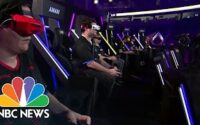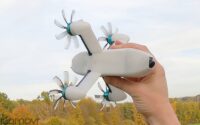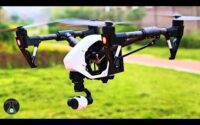Alligator vs Drone: A Clash of Nature and Technology
In the age of technological advancements, clashes between nature and technology have become increasingly common. One fascinating encounter that showcases this clash is the face-off between an alligator and a drone. This unexpected confrontation between a creature of the wild and a modern technological marvel highlights the complexities and consequences of our rapidly evolving world.
The alligator, a formidable reptile known for its powerful jaws and stealthy nature, represents the raw strength and adaptability of the natural world. On the other hand, the drone symbolizes human innovation and our desire to explore and understand the world around us. When these two worlds collide, it offers us a glimpse into the conflicts that arise when nature and technology intersect.
The encounter between an alligator and a drone begins with the drone’s intrusion into the alligator’s natural habitat. As the drone buzzes above, capturing aerial footage or performing some other task, the alligator perceives it as an unwelcome invader. In its territorial instincts, the alligator reacts defensively, responding to the foreign object with aggression.
With lightning-fast reflexes, the alligator lunges at the drone, attempting to seize it in its powerful jaws. The drone, equipped with advanced maneuvering capabilities, evades the alligator’s attack, showcasing the resilience and nimbleness of technology. The clash between the ancient predator and the cutting-edge gadget is both captivating and thought-provoking.
This encounter not only highlights the clash of nature and technology but also raises ethical questions. Are drones encroaching too far into wildlife habitats? Are we disturbing the delicate balance of nature with our technological intrusions? As we continue to integrate technology into every aspect of our lives, we must consider the impact on the natural world and find ways to coexist harmoniously.
The clash between an alligator and a drone reminds us of the ever-evolving relationship between nature and technology. It serves as a reminder that while technological advancements have brought us great benefits, they also have the potential to disrupt and harm the delicate ecosystems we share with other species.
The Drone: A Versatile Technological Marvel
Drones have revolutionized various industries with their remarkable capabilities and applications. From aerial photography and surveillance to delivery services and search and rescue operations, these unmanned aerial vehicles (UAVs) have proven to be a versatile technological marvel. However, when it comes to encounters between drones and formidable creatures like alligators, their abilities and limitations are put to the test.
First and foremost, drones provide a unique perspective on the world, allowing us to capture stunning visuals and gather valuable data from the sky. Their maneuverability and stability enable photographers and filmmakers to achieve shots that were once only possible with expensive helicopters or cranes. Drones equipped with high-resolution cameras can capture breathtaking aerial footage of wildlife, including alligators in their natural habitats, without causing any disturbance or endangering the animals.
In terms of surveillance, drones offer an advantage in monitoring alligator populations and behavior. With their ability to fly over inaccessible areas, drones can provide researchers and conservationists with valuable insights into the habits and habitats of these ancient reptiles. This information can contribute to better conservation efforts and aid in mitigating human-wildlife conflicts.
While drones have many advantages, they also have limitations when encountering creatures like alligators. Alligators are known for their strength and agility, making them potentially hazardous to drones. An aggressive alligator could snap at a drone, damaging or destroying it with its powerful jaws. Moreover, alligators are capable swimmers and can launch sudden attacks from underwater, making it challenging for a drone to evade such an ambush.
To minimize risks and ensure the safety of both the drone and the alligator, it is crucial to follow regulations and guidelines set by aviation authorities and wildlife management agencies. Pilots should maintain a safe distance from alligators and other wildlife, avoiding any actions that could provoke them. It is essential to prioritize the well-being of the animals and respect their natural habitats while utilizing drones for research or recreational purposes.
Impact on Wildlife Research
In recent years, the use of drones in wildlife research has become increasingly popular. These unmanned aerial vehicles (UAVs) offer researchers a unique perspective and the ability to collect valuable data on various species and their habitats. However, when it comes to encounters between drones and wildlife, particularly large predators like alligators, there are potential impacts that need to be considered and mitigated.
One of the primary concerns regarding alligators and drones is the potential disturbance caused by the presence of UAVs. Alligators are known to be sensitive to human disturbances, and the sight and sound of a flying drone may disrupt their natural behaviors. This disturbance could lead to altered movement patterns, reduced feeding, or even abandonment of critical habitats. Therefore, it is crucial for researchers to minimize the impact of their drone flights on alligator populations.
To address this issue, researchers have been implementing several strategies. First, they have been establishing recommended flight altitudes and distances to maintain a safe distance from the alligators. This helps to minimize any potential disturbance while still allowing for effective data collection. Additionally, using drones with quiet propellers and employing slow and gradual flight maneuvers can further reduce the impact on alligator behavior.
Another consideration is the potential for physical harm to the alligators or damage to the drones. While alligators are not known for being aggressive towards drones, accidental collisions can occur, potentially causing injuries to the animals or leading to equipment loss for the researchers. To mitigate this risk, researchers are encouraged to operate drones with caution and respect for the wildlife, ensuring that they maintain a safe distance at all times.
Furthermore, the use of thermal imaging cameras mounted on drones has proven to be a valuable tool in wildlife research, including alligator studies. By detecting heat signatures, researchers can gain insights into alligator populations, behavior, and habitat preferences. This non-invasive method reduces the need for direct contact with the animals and minimizes potential disturbances caused by ground-based observations.
The Future: Coexistence or Conflict?
In the realm of technological advancement, the collision between nature and innovation is becoming increasingly apparent. One intriguing example of this clash can be witnessed in the face-off between alligators and drones. These two seemingly disparate entities find themselves on a collision course, raising questions about the future: will it be one of coexistence or conflict?
Alligators, the ancient reptilian predators that have roamed the Earth for millions of years, now find themselves confronted by a new and unfamiliar opponent: drones. With their ability to fly and capture aerial footage, drones have become a popular tool for photographers, scientists, and hobbyists alike. However, when these unmanned aerial vehicles venture into the territories of alligators, tensions arise.
The clash between alligators and drones stems from a fundamental conflict of interests. Alligators, as apex predators, have established their habitats in secluded areas, away from human interference. Drones, on the other hand, encroach upon these sanctuaries, disrupting the alligators’ natural behavior and potentially causing stress or harm.
The use of drones in alligator-inhabited areas has sparked debates among scientists, conservationists, and drone enthusiasts. Some argue that drones can provide valuable insights into alligator behavior and help monitor populations for conservation purposes. These proponents advocate for responsible drone usage, emphasizing the importance of maintaining a safe distance and minimizing disturbances to the animals.
Others, however, express concern about the potential negative impacts of drones on alligators. The sudden presence of a buzzing drone can trigger defensive responses in alligators, leading to increased aggression and potential harm to both the animals and humans. Additionally, repeated disturbances could disrupt vital mating rituals and nesting behaviors, further endangering alligator populations.
To navigate this emerging conflict, stakeholders must find common ground to ensure the coexistence of alligators and drones. The development of guidelines and regulations for drone operation in alligator habitats is essential. These guidelines should prioritize the safety and well-being of both the animals and drone operators, while still allowing for valuable research and documentation.
Furthermore, technological advancements can play a role in mitigating the conflict. Innovations such as noise-reducing propellers or the use of infrared cameras can help minimize the disturbance caused by drones, ensuring a less intrusive presence. Additionally, education and awareness campaigns can promote responsible drone usage and foster understanding among drone enthusiasts about the potential consequences of their actions.
Ultimately, the future relationship between alligators and drones will depend on the choices we make today. If we prioritize the protection and conservation of alligator habitats while embracing responsible drone usage, coexistence becomes a viable possibility. However, if conflicts persist and precautions are not taken, the clash between these two forces may escalate, jeopardizing both alligators and the potential benefits drones offer.



